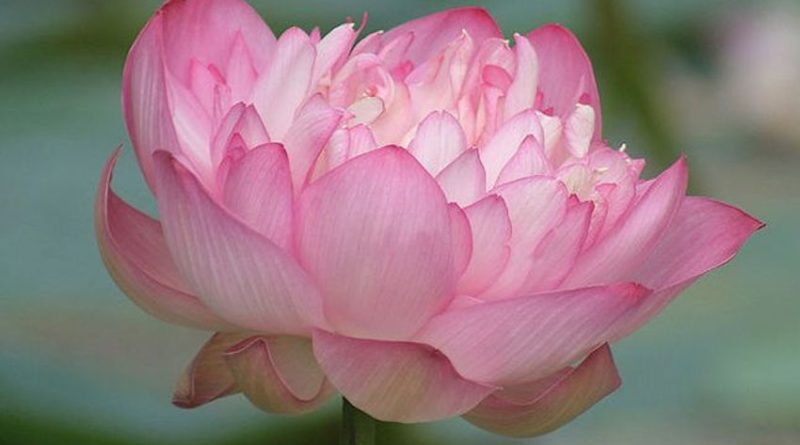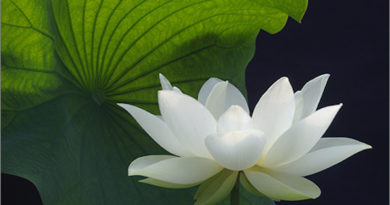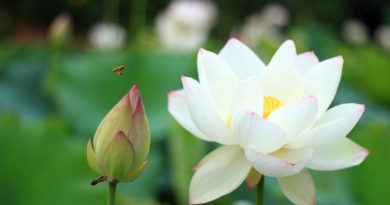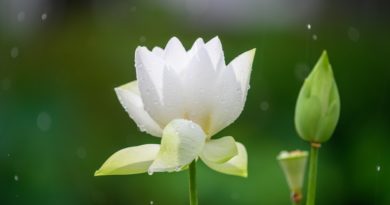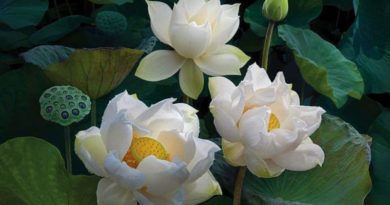DHAMMA RATANA – CHAPTER 13: THE FACTORS OF ENLIGHTENMENT
DHAMMA RATANA – CHAPTER 13: THE FACTORS OF ENLIGHTENMENT
“The Bojjhanga Sutta” is the title of today’s sermon “Bojjhan’ or ‘Bodhi’ means an ariya who discern the Four Noble Truths and “anga’ means factors. In other words, it means the Factors of Enlightenment. These factors can cure diseases. Moreover if one develops them, one will become an ariya. The Seven Factors of Enlightenment are
1. Sati Sambojjhan … Mindfulness especially vipassana mindfulness
2. Dhammavicaya Sambojjhan Investigation of the Law. Here it renders vipassana wisdom, which analyses anicca, dukkha and anatta.
3. Viriya Sambojjhan … Energy, especially vipassana energy put forth in noting nama and rupa.
4. Piti Sambojjhan … Rapture due to the progress of insight.
5. Passaddhi Sambojjhan … Tranquility at the stage of Udayabbaya Nana.
6. Samadhi Sambojjhan … Concentration.
Khanika (momentary) concentration on each and every noting of the object of noting from the beginning to the end, while practising the vipassana meditation. In accordance with Rev: Mahasi Sayadaw’s instruction, while noting “rising’ “falling”, the concentration is established from the beginning to the end of “rising” and the same with “falling.”
7. Upekkha Sambojjhan Equanimity. At the higher stages of Nana, especially at the mature Udayabbaya Nana stage and the Sankharupekkha Nana stage the noting mind arises simultaneously with the object of noting. There is no suffering nor pleasantness.
1. Sati Sambojjhan
By practising satipatthana meditations, one can become an ariya and whenever satipatthana meditation is practised, the seven Factors of Enlightenment are developed. In satipatthana meditation a yogi has to be mindful at every noting such as “sitting”, “touching”, “rising”, “falling”, walking”, “standing”, etc:. You certainly will miss the arising object of noting, if you are not mindful. The word “Satipatthana” is composed of “Sati”=mindfulness + “upa’=settle or dwell+ thana=exist. It means the mind settles or fixes on the object of noting. There is, as a matter of fact, no excess in mindfulness. It is always lacking. Mindfulness will foster vipassana wisdom. Whenever you practise vipassana meditation, by noting “sitting”, “walking”, standing”, etc: the Factor of Mindfulness is developed. To be mindful is the utmost importance in vipassana meditation.
2. Dhammavicaya Sambojjhan
Dhamma=Law + vicaya=investigation of dhamma. It is rendered here as wisdom (Nana) especially vipassana wisdom. At the beginning of vipassana meditation, the Dhammavicaya Sambojjhan is not yet developed as yogi could not distinguish nama and rupa. He thinks, it is himself who is sitting and it is his abdomen which is rising; it is himself who is sitting and it is he who is noting. It is the same way in noting other behaviour. The “rising” and the noting mind appear to him as a whole not as separate entities. When concentration is established, then only yogi realizes that noting mind and “rising” are two separate entities.
Furthermore he notices that “rising” and “falling” are rupa which has no consciousness. The noting of rising “falling” is the conscious mind. Now he can distinguish between nama and rupa and also realizes that there are just nama and rupa and nothing else in himself. Thereupon, he has gained the stage of Namarupa Pariccheda Nana. Thence the Dhammavicaya Sambojjhan is developed. Nama=con- sciousness + rupa=body + pariccheda=differentiating + nana=insight or wisdom. It means the wisdom which can differentiate between nama and rupa. It is better for a yogi, to know the stage of insight that he has attained. Vipassana wisdom is Dhammavicaya Sambojjhan. Though the stages of insight has progressed the Factor of Enlightenment has not done so.
At the Paccaya pangghaha Nana stage, yogi comprehends that, he could note “rising”, “falling”, sitting “standing”, and so on due to the manifestation of “rising behaviour, “siting” behaviour, “touching” behaviour and so on. Thereupon it is apparent to him that the rising “falling”, behaviour etc: are the causes and the noting of them is the effect. Moreover he notices that “rising” shifts from the abdomen to the side of his body, to the arm, chest, neck and the top of his head. At that stage yogi reports, “I do not know how to note as “rising” is no longer at the abdomen. It has shifted to the arm or the chest”. The meditation instructor tells him to note “rising” and “falling” wherever they manifest. Thus the yogi apprehends the cause and effect. Yellow, blue or green colours may also appear in his mental eyes. All these are due to the Dhammavicaya Sambojjhan.
The meditation instructor, from the very beginning, advises the yogi to make general noting, in detail so as to gain dhamma in a short time. At the Nama-rupa pariccheda Nana stage, the meditator could not follow the advice, however at the Paccayaparigghaha Nana stage, he is able to note general action in detail. When he is especially mindful, he could note the intention. After sitting for an hour, the intention to stand up arises, then note, “intend to stand”, “intend to stand”. Due to this intention the element of motion pushes up the body by the hands. When the body moves upward, note, “standing” “standing”. Note objectively and mindfully to apprehend the nature of the phenomena or paramatta. In vipassana meditation, it is necessary to note the nature.
Note the process of upward movement of the body precisely. Thereupon lightness or buoyancy in the body will be distinctly noticed. It is not to note legs, arms, head, etc:
After standing up, yogi has to be especially mindful, then only he will perceive the intention to walk vividly when it occurs. Then note “intend to walk”. “intend to walk”. Note “walking”. “walking” when the walking movement of the body starts. Then note “left foot forward”, “right foot forward”, when you start walking and also “lifting”, “pushing forward”, “dropping” according to the moving action of the foot. When the intention to stop arises about 2 or 3 steps before stopping, note “intend to stop”, “intend to stop”. Note “stopping”, “stopping” when the body prepares to stop, that is when the stopping action occurs.
When the intention to sit arises, note “intend to sit”, intend to sit”. Then the intention to sit causes the clement of motion to push the body downwards. Then note “sitting”, “sitting” as the sitting behaviour appears. It is to note the nature of the process of sitting behaviour, however not the form of the body. If you can apprehend the heaviness in the moving process of sitting behaviour, you then cognize the nature of the phenomena. Thus you can note the intention to sit, that of touching, that of standing, that of walking, before you sit, touch, stand and walk. Thereupon you have achieve one stage of insight, namely Nama-rupa pariccheda Nana. And the Factor of Enlightenment, Dhammavicaya Sambojjhan is developed. The intention to stand is nama and the standing behaviour is rupa and they are perceived as two separate entities. That means you can now differentiate nama and rupa.
At the same time you comprehend the cause and effect. The stage of insight you now achieved is the Paccayaparigghaha. Nana and the Factor of Enlightenment developed is the Dhammavicaya Sambojjhan. Thus you have gained two stages of insight, however the Factor of Enlightenment has not changed. It is required to note the intention prior to the actual movement in noting the behaviour. It is essential to note the conscious mind in detail when practising vipassana meditation. Then only there will be progress in the stages of insight.
Motto: Intention to sit is nama
The act of sitting is rupa
It is not “I” or “you” who sit
Just nama and rupa that sit
If the pair is well conceived
Then the purpose of sitting is achieved.
Intention to stand is nama
The act of standing is rupa
It is not “I” or “you” who stand
Just nama and rupa that stand
If the pair is well conceived
Then the purpose of standing is achieved.
The Yogi establishes a firm foundation upon comprehending the cause (intention to sit) and the effect (sitting behaviour). The Athakatha masters remarked that the yogi has a good standing which will prevent him from sufferings in apaya, beginning from the subsequent existence and he is a Sula-Sotapan (junior sotapan). No other belief can influence him and he is much relieved as he has no doubt in the cause and effect relationship. He no longer has faith in the belief that there is no cause for sufferings or happiness. He is also free from the “creation” belief which is incongruent to cause and effect. The creation is cause and to become a living being is effect. It is certain that the creator such as God, Brahma and Pissano create with loving- kindness for all living beings to be equal. But in fact not all are equally created. Some are of good health, good wealth and have good personality. However there are people who are of mediocre health, wealth and appearance. There are also people of very low birth. Even the twins are not equally healthy and wealthy. It is quite evident that the cause (creation) and the effect (living beings) are incongruent.
Cause and effect relationship is conspicuous to you through your own experience. In other words you can understand clearly that if one has done bad deeds, one will have sufferings: if he has done good deeds, he will then enjoy pleasantness, if one harbours unwholesome disposition, he will encounter unpleasantness and so on. The good cause of the past existence will lead to good effect in the present. Certainly one will have good births in the round of samsara.
At the Sammasana Nana Stage the yogi experiences all kinds of sufferings such as, giddiness, swaying, aches, numbness, pushing and pulling, itching, etc:. Thereupon he analytically realizes that his body is merely a mass of sufferings. Thus the Factor of Enlightenment, Dhammavicaya Sambojjhan is developed. The stage of insight is the Samma sana Nana, the analytical knowledge of phenomena. In other words, to comprehend the impermanence of vedana. Vipassana meditation is practised not to experience aches and pains, however yogi is presently suffering from them. Since it is not in accordance with his wish, vedana goes on of its own accord, it is anatta or uncontrollable. The Factor of Enlightenment, Dhammavicaya Sambojjhan develops when the three characteristics, namely anicca, dukkha and anatta are lucidly realized
By virtue of the repetitive noting vedana is overcome. If the yogi experienced too much vedana, he is likely to be oppressed and begins to ponder thus, “the Buddha preached that dhamma is subtle and blissful. Though it was not so painful at the beginning, however after practising a few days I am now suffering. It is just the opposite of the Buddha’s Teaching. I doubt whether I will gain dhamma.” Thereupon the meditation instructor encouraged him, “At the Sammasana Nana Stage, yogi usually experiences more pain and aches. When you pass this stage, there will be pleasantness. It is a good sign of progress in dhamma, although it is unpleasant for the yogi. You will find happiness in a few days”. As the vedana is overcome by earnest noting, yogi has pleasantness and suffers less pain.
Unlike the Sammasana Nana stage, at the Udayabbaya Nana stage though he may still sway as before, there is no feeling of heaviness and he feels buoyant and light in body. His body is light just like a leaf floating in the air. He has reached a higher stage of insight. He is both physically and mentally subtle: his body and mind are light: his behaviour and actions are pliable. Moreover he finds that he is both physically and mentally proficient. Those yogi, in the lower stage of insight who have to change posture two or three times in an hour sitting, now at the Udayabbaya Nina stage can sit without changing. Those who can sit an hour without changing, can now sit for 2,3,4 or 5 hours, because his body is both physically and mentally pliant.
4. Piti Sambojjhan
Furthermore the noting mind and the object of noting now occur simultaneously as his body and mind are proficient and well practised. Thereupon noting becomes easy and continues on its own accord. There is also physical and mental tranquility which foster vipassana piti. The Factor of Enlightenment, the Piti Sambojjhan has developed and the stage of insight has also changed to the Udayabbaya Nana stage.
A yogi reported thus, “My body is calm and erect like a doll, and noting is effortless. It appears to me I’m just watching it with no concern. I would not know, how to express my feeling of pleasantness and quietude.” A yogi practising in a secluded place, gains dhamma when vipassana wisdom is mature. Thence he enjoys both physical and mental rapture which, leave alone an ordinary person, not even a deva could have a chance to experience,” remarked the Lord. This is the Piti Sambojjhan. At this stage of Udayabbaya Nana, yogi enjoys vipassana piti so much, so that he mentally proclaimed, “It is a good opportunity for me to be a human being in this very life. I’m certain, I shall realize nibbana with this disposition.” Thus the Piti Sambojjhan is developed.
Five kinds of Piti
1. Khuddaka Piti, the thrill of joy that causes the flesh
to creep or a creep in the chest just for one time.
2. Khanika Piti, instantaneous joy like a flash of lightning. The flesh creeps or a creep occurs in the chest quite often. Then note “creeping”, “creeping”. Sometimes feels like crying then note “want to cry” “want to cry.”
3. Okkantika Piti, the flood of joy like the breakers on a sea-shore. Sometimes it starts from the upper part of the body and spreads downwards; or sometimes it starts from the lower part of the body and pervades to the upper part Yogi feels as if he is splashed with cool water, however it is unlike the natural heat and cold of the environment
4. Ubbega Piti, Transporting joy which enables one to float in the air just like a lump of cotton carried by the wind. Sometimes hands and legs lifted up by themselves or the body moves afloat. Yogi may feel like crying or sometimes laughing. He may also experience as if he is being pushed and pulled by someone. He may also hear sound: All these are due to the Factor of Enlightenment, Pin Sambojjhan. To those who are timid by nature it seems to be a ghost or a spirit is making all these sound and pushing and pulling as he finds no one when he looks around. Thence the rumour spreads that the meditation centre is haunted. Therefore yogi is frightened and dhamma does not progress. However all these are due to the Piti Sambojjhan. The knowledge about this Sambojjhan will help yogi to contemplate as before. Sometimes it could be so strong that yogi falls down as if pushed by someone. He may shed tears which is known as cold tears due to vipassana piti. The tear due to economic ruins is hot tear.
Quite often yogi may like to cry or laugh. “Am I going mad? I want to cry now and then I want to laugh again.” You are not mad. When you want to cry just note “want to cry”, “want to cry”, if you want to laugh then note “want to laugh”, “want to laugh”. Incessant noting will overcome these feelings. An ordinary person may think, it is ridiculous to note “want to cry” when one wants to cry. To a meditator. however, it is different. If one can note the desire to cry,
he will overcome it and no longer wants to cry. If he notes “want to laugh”, then he will laugh no more. The Buddha’s method is useful in controlling the conscious mind.
5. Pharana Piti, the suffusing joy which pervades the whole body like a full blown balloon or like a flood that overflows small lakes and tanks. The sensation of eye, ear, nose, tongue and body are quite blissful.
Dhamma may progress due to piti. The Piti Sambojjhan develops at the Udayabbaya Nana Stage. The Passaddhi Sambojjhan also develops at this stage of insight. Yogi experiences the physical and mental tranquility which he would not be able to express. It is so calm and tranquil that he could sit erect like a doll and it happens of its own accord.
Samadhi Sambojjhan
The Samadhi Sambojjhan is more conspicuous at the mature Udayabbaya Nana Stage. The noting mind is fixed on the object of noting as soon as it appears. This is due to the strong concentration, the Samadhi Sambojjhan. The noting mind settles firmly on the object of noting from the beginning to the end of “rising” and “falling”. That is known as Khanika Samadhi (momentary concentration). Sometimes yogi may not be able to move his touching hands or his body, while sitting. All these are due to the strong concentration which has pervaded to the bodily behaviour. That is termed as Appana Samadhi attainment or full concentration, existing during absorption. This again is due to the well established posture, (ariya patha).
Upekkha Sambojjhan
Upekkha Sambojjhan is vivid at the mature Udayabbaya Nana Stage, however it is more conspicuous at Sankharupekkha Nina Stage. The noting mind and the arising of the sense object occur simultaneously. There is no fear or happiness and the equilibrium between suffering and happiness exists firmly.
Motto: Free from fear and fondness
Equal view of sufferings and happiness
Contemplation comes with no difficulties
San-kharu’s three characteristics of equanimity
At the Banga and Baya Nina stages there occurs fright, however at the Sankharupekkha Nana Stage the thought of the external sense objects no longer causes fear. Furthermore there develops no attachment nor fondness of the sense objects or the dhamma. Yogi can perceive pleasantness with no attachment and, the pain and sufferings without unhappiness. Thus the Factor of Enlightenment, Upekkha Sambojjhan is developed. Since dhamma has well developed in all aspects the ordinary aches and pains can be cured easily by noting them. The experienced yogis are quite aware of the fact that by dint of physical and mental tranquility, dhamma could cure not only the ordinary diseases but also the serious ones. While contemplating, they could spot the exact seat of the disease and by successive noting of it, the disease disappears.
Here is the case of an elderly yogi who suffered from stiffness of her hand. The ordinary medicine could not cure her. She came to the meditation centre. The stiffness of her hand became more serious. While meditating, she felt that the nerves from her hand were pulled out or massaged. It also appeared to her as if somebody was pulling or pushing her hand. She kept on noting these manifestations and consequently reached the Sankharupekkha Nana Stage. This stage of insight is well known as a curing stage of nana. The stiffness of, her hand was cured, however, it was not distinct as she had not used her hand often while contemplating. When she went home, she found out that she could move her hand as normal, she could touch her head; she could move her hand backward and forward. At the Sankharupekkha Nana Stage she had struck the equilibrium between pleasantness and unpleasantness, thus the Factor of Enlightenment, Upekkha Sambojjhana has developed.
Another illustration of the establishment of equanimity at the Sankarupekkha Nina Stage is:- a lady of worldly pleasure took delights in dance and songs. She used to record her favourite songs and listened to them frequently. When she attended a dance-show, she paid attention to a particular dancer out of 10 or 16 dancing girls and was critical of her dancing steps. One day she came to the meditation centre and went home after gaining the Sankharupekkha Nina Stage. At home she played the song as before however they were no longer pleasant and enjoyable. This illustrates that because of her attainment of the Sankharupekkha Nana Stage, she was no longer interested in the pleasantness or the unpleasantness. She could view them equally. The Upekkha Sambojjhan has developed according to the stages of insight. Then the object of noting and the noting mind appear simultaneously.
To develop the Factors of Enlightenment, it is the best to practise satipathana meditation or vipassana meditation. Thus the Factors of Enlightenment are the characteristics of an ariya who has acquired the Four Noble Truths. One should be mindful to be an ariya, if not he may never be one. Whatever you do, it must be wisdom predominated; do it energetically, otherwise you will not be an ariya. You must contemplate diligently, so that your noting conscious mind never misses the arising sense-objects.
1. While practising the vipassana meditation, to be mindful to note the occurring sense-objects, is the Factor of Mindfulness, the first Constituent of Enlightenment.
2. While practising the vipassana meditation, the development of vipassana wisdom is the Factor of Investigation of the Law or dhamma, the second Constituent of Enlightenment.
3. While practising vipassana meditation, to endeavour to note the appearing sense-objects, is the Factor of Effort, the third Constituent of Enlightenment.
4. The development of piti (rapture) during the vipassana meditation is the Factor of Rapture, the fourth Constituent of Enlightenment.
5. The development of physical and mental calm during the vipassana meditation is the Factor of Tranquility, the fifth Constituent of Enlightenment.
6. The development of concentration during the vipassana meditation is the Factor of Concentration, the sixth Constituent of Enlightenment.
7. The indifferent contemplation of pleasure and pain during the vipassana meditation is the Factor of Equanimity, the seventh Constituent of Enlightenment.
One can become a sotapan or an ariya, when these seven Constituents of Enlightenment are developed during the vipassana meditation. Moreover various diseases can be cured too.
By listening to this discourse on “The Factors of Enlightenment”, may you all be able to practise in accordance with the Buddha’s instruction. With diligent contemplation, may you all immediately realize your most aspired Nibbana, the cessation of all sufferings, by practising with ease.

